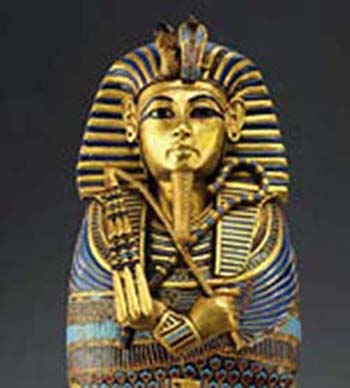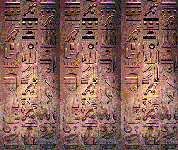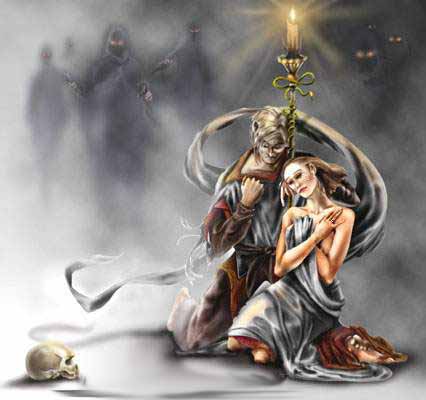

A curse (also called execration) is any manner of adversity thought to be inflicted by any supernatural power, such as a spell, a prayer, an imprecation, an execration, magic, witchcraft, a god, a natural force, or a spirit. The study of the forms of curses comprise a significant proportion of the study of both folk religion and folklore. The deliberate attempt to levy curses is often part of the practice of magic.
The study of the forms of curses comprise a significant proportion of the study of both folk religion and folklore. The deliberate attempt to levy curses is often part of the practice of magic. In Hindu culture the Sage or Rishi is believed to have the power to bless and curse. Examples include the curse placed by Rishi Bhrigu on king Nahusha and the one placed by Rishi Devala.
Special names for specific types of curses can be found in various cultures:
African American voodoo presents us with the jinx/haitians and crossed conditions, as well as a form of foot track magic, whereby cursed objects are laid in the paths of victims and activated when walked over. Middle Eastern and Mediterranean culture is the source of the belief in the evil eye, which may be the result of envy but, more rarely, is said to be the result of a deliberate curse. In order to be protected from the evil eye, a protection item is made from dark blue circular glass, with a circle of white around the black dot it the middle, which is reminding a human eye. The size of the protective eye item may vary.
German people, including the Pennsylvania Dutch speak in terms of hexing (from the German word for witchcraft), and a common hex in days past was that laid by a stable-witch who caused milk cows to go dry and horses to go lame. Indian people use the word Shaap in Hindi and Marathi; Sabam in Tamil.
Greek and Roman curses were somewhat formal and official. Called katadesmoi by the Greeks and tabulae defixiones by the Romans, they were written on lead tablets or other materials, generally invoked the aid of a spirit (a deity, a demon, or one of the dead) to accomplish their aim, and were placed in a location considered effective for their activation, such as in a tomb, cemetery, or sacred spring or well. In the text of katadesmoi and defixiones, the petitioner uttered a prayer or formula that the enemy would suffer injury in some specific way, such as theft or loss of respect, along with the reason for the curse. The Romans, Etruscans, and Greeks in Italy all practiced this custom. They buried the curses so well that today we have a body of curse inscriptions to tell us how they did it.
In the Celtic world there were also many different forms of curses. Some of the most well known from Ireland are Curse stones, Egg curses, New Year curses and Milk curses. Curse stones generally involved particle stones with the power to curse. One example involved turning a stone three times and saying the name of the person you wanted to curse. Egg curses are a fertility curse. If you buried/hid eggs on someone else's land it was believed you could steal their land's fertility and therefore their luck. There are also some well documented methods believed to break these curses. New year curses are like egg curses. If you took something from someone on the new year you took their luck for the year. People used to not clean their house or throw out water for this reason. In Munster you can see a similar form in the may bush and the stealing of may bushes. Stealing back the item or bush is believed to return the luck. Milk curses were curses put on a household where the milk from others cows went to yours.
The first curse in the Bible is put on the serpent by God, "You are cursed more than all cattle", (Genesis 3:14). As a result of Adam and Eve disobeying God, the ground is also cursed: "Cursed is the ground for your sake; in toil you shall eat of it All the days of your life." (3:17). Cain is cursed from the earth, "So now you are cursed from the earth", (4:11). In the New Testament Paul sees curses as central to the meaning of Jesus's crucifixion. In Galatians 3:13 he says: "Christ redeems us from the curse of the law by becoming a curse for us...". He refers to Deuteronomy: " anyone who is hung on a tree is under God's curse." (21:23 RAEDM)
A number of sections of the Talmud show a belief in the power of curses (Berachot 19a, 56a.) In some cases, a curse is described as related to the nature of a prayer (Ta'an. 23b); an undeserved curse is described as ineffective (Makkot 11a) and falls back upon the head of him who utters it (Sanhedrin 49a). Not only is a curse uttered by a scholar unfailing in its effect, even if undeserved (Mak. 11a), but one should not regard lightly even the curse uttered by an ignorant man (Meg. 15a). The Biblical prohibitions of cursing are legally elaborated, and extended to self-cursing (Shebu. 35a). A woman that curses her husband's parents in his presence is divorced and loses her dowry (Ket. 72a). Cursing may be permissible when prompted by religious motives. For instance, a curse is uttered against those who mislead the people by calculating, on the basis of Biblical passages, when the Messiah will come (Sanhedrin 97b). Cursed are those who are guilty of actions which, though not forbidden, are considered reprehensible. According to legend, some rabbinic scholars cursed sometimes not only with their mouths, but also with an angry, fixed look. The consequence of such a look was either immediate death or poverty (Sotah 46b, and parallel passages).
Certain landmarks or locales are said to be cursed. Various lakes, rivers and mountains have been called cursed, as has the Sargasso Sea. However even when there is a tradition of a place "taking someone" every number of years it is not always considered cursed. For example, someone is said to drown in Lough Gur in Limerick, Ireland every seven years but the lake is not considered "cursed" by the locals. The alleged Bermuda Triangle effect is believed by some to be some form of curse (and by others to be some unexplained natural phenomena).
Babinda's Boulders, Babinda township, near Cairns, Queensland on Australia's mid-north coast, is a place known for the Devil's Pool, a group of waterholes known to be dangerous to young male travelers, but never claiming the lives of locals or females. There is some dispute about the dangers, that the geography of the place is naturally risky with the rocks and fast moving currents &em; yet an Aboriginal legend exists giving it the context of a historic curse.
Curse of the United States Presidency: Curse of Tippecanoe (also known as Tecumseh's Curse) is used to describe the regular death in office of Presidents of the United States elected or re-elected in years evenly divisible by twenty, from William Henry Harrison (elected in 1840) through John F. Kennedy (1960). Ronald Reagan, elected in 1980, was wounded by gunshot but survived; George W. Bush (2000) survived his terms in office, despite at least one close assassination attempt.
The Curse of 27 is the belief that 27 is an unlucky number due to the number of famous musicians and entertainers who have died at the age. Robert Johnson, Jim Morrison, Brian Jones, Jimi Hendrix, Ron "Pigpen" McKernan, Janis Joplin, Jonathan Brandis and Kurt Cobain are all believed to have been affected by the curse of 27. This is also known as the 27 Club.
Cursed objects are generally supposed to have been stolen from their rightful owners or looted from a sanctuary. The Hope Diamond is supposed to bear such a curse, and bring misfortune to its owner. The stories behind why these items are cursed vary, but they usually are said to bring bad luck or to manifest unusual phenomena related to their presence. The television show Friday the 13th: The Series dealt with a hoard of cursed antiques sold by an evil man that gave their owners various powers in return for killing. Once cursed, the objects were indestructible and had to be stored in a special vault.
Real or Not? 6 Famous Historical Curses Live Science - August 5, 2013

Humans can be a superstitious lot, but some historical curses seem too real to be mere coincidence or simple superstition. From King Tutankhamun to the Chicago Cubs, check out these six famous historical curses. The Curse of Otzi. The Mummy's Curse. The Curse of Timur's Tomb. The Curse of the Hope Diamond. The Curse of Tippecanoe. The Goat and the Curse of the Chicago Cubs - Sports Related Curses.
The most universal method of laying on a curse is by effigy, which is an image or representation of the victim, or the person who is wished to be harmed. Waxed effigies were common in ancient India, Persia, Egypt, Africa and Europe, and currently are still used. Also, effigies can be made of clay, wood and stuffed cloth (poppets). Often the effigy is marked or painted to looked like the victim. It is thought that the closer the effigy resembles the victim, the more the victim will suffer when the effigy is harmed or destroyed. The theory behind the harming or destroying an effigy to do harm to a victim is pure sympathetic magic. As the effigy is harmed, so the victim is harmed. When the effigy is destroyed, so the victim dies.
The ancient Egyptians often used waxed figures of Apep, a monster who was the enemy of the sun. The magician would write ApepÕs name in green ink on the effigy, wrapped it in new papyrus and throw it into a fire As it burned he kicked it with his left foot four times. The ashes of the effigy were mixed with excrement and thrown into another fire. The Egyptians also left waxed figures on tombs.
Like blessings, curses have universally been bought and sold throughout the centuries. With the exclusion of the neo-Pagan Witches, witches and sorcerers throughout history have performed both blessings and curses as a service to others because both are calling upon supernatural powers to effect a change. They have rendered these services to client for fees, or in carrying out judicial sentences. Plato mentioned in the Republic, "If anyone wishes to injure an enemy; for a small fee they (sorcerers) will bring harm on good or bad alike, binding the gods to serve their purposes by spells and curses."
Waxed figures were popularly used during the Middle Ages and Renaissance in Europe by numerous witches. King James I, of England, described such activities in his book Daemonologie (1597):
Alternatives to melting of effigies has been to stick them with pins thorns or knives. Animal and human hearts have been used for substitutes. Hearts, animal corpses or objects which quickly decompose, such as eggs, are buried in the ground with spells that the victim will die as the objects deteriorate.
In Ireland "cursing stones" are stones that are stroked and turned to the left as the curse is recited. It has been frequently claimed that gems and crystals possess the power to hold curses. . The Hope Diamond purchased by Louis XVI from Tavernier in 1668, is thought to be cursed, because its owners have suffered illness, misfortune, and death.
Various legends abound in the United Kingdom and Europe of curses laid upon families, especially of the aristocracy. One of the most horrible curses was that of childlessness or death to the heirs, to the family lineage died out.
There is a broad popular belief in curses being associated with the violation of the tombs of mummified corpses, or of the mummies themselves. The idea became so widespread as to become a pop-culture mainstay, especially in horror films (though originally the curse was invisible, a series of mysterious deaths, rather than the walking-dead mummies of later fiction). The "Curse of the Pharaohs" is supposed to have haunted the archaeologists who excavated the tomb of Pharaoh Tutankhamun, whereby an imprecation was supposedly pronounced from the grave by the ancient Egyptian priests, on anyone who violated its precincts. Similar dubious suspicions have surrounded the excavation and examination of the (natural, not embalmed) Alpine mummy, Otzi the Iceman. While such curses are generally considered to have been popularized and sensationalized by British journalists of the 19th century, ancient Egyptians were in fact known to place curse inscriptions on markers protecting temple or tomb goods or property.
 Though magic was mainly used to protect or heal, the Egyptian state also practised destructive magic. The names of foreign enemies and Egyptian traitors were inscribed on clay pots, tablets, or figurines of bound prisoners. These objects were then burned, broken, or buried in cemeteries in the belief that this would weaken or destroy the enemy.
Though magic was mainly used to protect or heal, the Egyptian state also practised destructive magic. The names of foreign enemies and Egyptian traitors were inscribed on clay pots, tablets, or figurines of bound prisoners. These objects were then burned, broken, or buried in cemeteries in the belief that this would weaken or destroy the enemy.
 In major temples, priests and priestesses performed a ceremony to curse enemies of the divine order, such as the chaos serpent Apophis - who was eternally at war with the creator sun god. Images of Apophis were drawn on papyrus or modelled in wax, and these images were spat on, trampled, stabbed and burned. Anything that remained was dissolved in buckets of urine. The fiercest gods and goddesses of the Egyptian pantheon were summoned to fight with, and destroy, every part of Apophis, including his soul (ba) and his heka. Human enemies of the kings of Egypt could also be cursed during this ceremony.
In major temples, priests and priestesses performed a ceremony to curse enemies of the divine order, such as the chaos serpent Apophis - who was eternally at war with the creator sun god. Images of Apophis were drawn on papyrus or modelled in wax, and these images were spat on, trampled, stabbed and burned. Anything that remained was dissolved in buckets of urine. The fiercest gods and goddesses of the Egyptian pantheon were summoned to fight with, and destroy, every part of Apophis, including his soul (ba) and his heka. Human enemies of the kings of Egypt could also be cursed during this ceremony.
'Magical figurines were thought to be more effective if they incorporated something from the intended victim, such as hair, nail-clippings or bodily fluids. This kind of magic was turned against King Ramesses III by a group of priests, courtiers and harem ladies. These conspirators got hold of a book of destructive magic from the royal library, and used it to make potions, written spells and wax figurines with which to harm the king and his bodyguards.
Magical figurines were thought to be more effective if they incorporated something from the intended victim, such as hair, nail-clippings or bodily fluids. The treacherous harem ladies would have been able to obtain such substances but the plot seems to have failed. The conspirators were tried for sorcery and condemned to death.
The alleged "mummy curse" is on the tomb of Tutankhamen. It was discovered when the Earl of Carnarvon and Howard Carter excavated Tutankhamen's burial chamber in 1922. Legend has it that in an antechamber they found an inscribed clay tablet which read: Death will slay with its wings whoever disturbs the peace of the pharaoh.
Six months later Carnarvon died of an infected mosquito bite. Even though six of the seven principle members of the excavation team experienced strange or sudden deaths, thought to have been the result of the curse, the tablet was never photographed and strangely disappeared from the artifacts. Bob Brier, an American parapsychologist and Egyptologist, speculated the tablet never existed. In Ancient Egyptian Magic (1980), Briar notes that it is not typically Egyptian to write on clay tablets or to refer to death as having wings. Also, no other reliable sources exist that cite the curse.

Curses have always been part of our simulation to instill the emotions of fear and powerlessness into the human experience. Fear can manifest all sorts of lower frequency emotions. All curses, real or imagined, are broken at the End of the Illusion of Time.